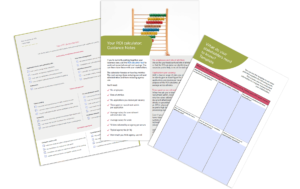New ATS? Here’s how to manage change successfully
If 2022 is the year you are planning on implementing a new Applicant Tracking System, then good news! You will soon be on your way to a more streamlined and automated hiring process.
Yet to make sure ATS implementation runs smoothly, it’s crucial you have an effective change management strategy to ensure stakeholders are engaged with the process, understand the reasons behind the project and are willing to adopt the new system.
We’ve spoken to some industry experts to find out their top tips on how to successfully prepare your organisation and stakeholders for an upcoming change.

Change management tips
- Preparation
One of the most valuable things you can do early on in an ATS implementation project is to prepare and plan for the change. This could include ensuring everyone involved understands why you are making the change and how it will impact the organisation; assessing whether your stakeholders are ready to embrace the change and adopt a new system; and identifying potential challenges that may arise as a result of the change.
“For preparation, it will help to understand the current process and the reasons for each step being included,” comments Philippa Barnes, director at ReThink HR Ltd. “You can then start to plan how you can redesign the process to make it more efficient with the new ATS.”
Helen Armstrong, CEO and founder of Silver Cloud HR, adds that it is absolutely crucial to plan every stage of the process. “Plan your requirements gathering, map your stakeholders, plan your project out and plan your communications. You cannot over plan! Document it all and validate it with the stakeholders.”
- Project management
Effective project management starts with identifying project team members and ensuring they are aware of the importance of incorporating change management strategies into the project management process; and emphasising the requirement for them to be change champions throughout the project.
“You cannot over plan!”
– Helen Armstrong
“Project management naturally involves multiple stages, and some will require teams to undertake large pieces of work that will have benefits in the long run, such as cleansing data,” says Philippa Barnes. “Making sure that everyone is aware of why a task needs to be completed, and the benefits it will bring in the long run, can help you keep the whole project team focussed and on track.”
- Communication
Clear, regular communication is a vital part of any change management strategy. Ensure you know who you need to communicate with, how you are going to reach them and what kind of information you need to get across.
“Communication about what will be changing and the benefits it will bring is crucial to get engagement throughout the project,” remarks Philippa Barnes. “It may also be helpful to clarify anything that will not be changing and the reasons for that, so that expectations are effectively managed.”
Communication must not stop once you reach go-live either, points out Helen Armstrong. “Don’t assume that the project ends at go-live. The hardest stage is adoption, so your communication plan needs to extend long beyond the go-live date. How will you measure performance? How will you communicate the benefits? And who is responsible for communicating this?”
How to speak the language of your stakeholders
One way to ensure you engage with your stakeholders during a change project is to involve them right from the start and share the aims of the project with them.
“Involving your stakeholders in every aspect of the process will help you understand their language and, more importantly, the areas that they are most passionate about,” remarks Helen Armstrong. “What questions do they ask during your conversations? What is important to them? Map out your stakeholders and detail what aspects of the new ATS they will be involved in and what success looks like to them.”
How to approach reluctant adopters
Whatever technology change project you may be undertaking, there will always be people who are resistant to change – it is simply human nature – but there are some things you can do to provide support.
“The best way to approach reluctant adopters is to try and avoid them becoming reluctant adopters in the first place,” advises Helen Armstrong. “Involving key stakeholders during the planning and preparing phases will be key to gaining buy-in at the point of go-live. Are you able to identify who might be reluctant to the change at the beginning? If so, put some extra work in with those people to gently nudge them along the journey. Asking for their views goes a long way in buying their trust and gives you the opportunity to explain how it will benefit them.”
Philippa Barnes has a couple of tried and tested strategies to help get people engaged. “The first is to involve them closely in the project from the beginning; this can work if they know there is a problem that a new ATS can help resolve but they do not yet have the understanding about what is possible.
Sharing the potential with them can help bring them on board. Second, if you find you have reluctant adopters once the ATS is in place, you should be able to find internal case studies and advocates for the new process and use them to encourage more engagement from those who have been less keen to embrace progress.”
 Are you still building your ATS business case? Or about to, but not sure where to start?
Are you still building your ATS business case? Or about to, but not sure where to start?
The complete ATS Buyer’s Toolkit has a range of resources and templates to help you build an effective ATS business case.
From an interactive ROI calculator and stakeholder template, to a handy ATS demo checklist, everything is included to help you present a compelling case for a new Applicant Tracking System.



